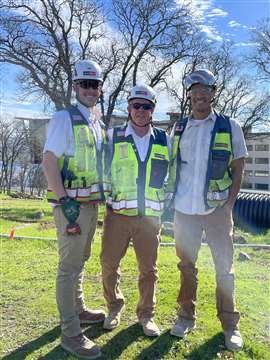How construction firms are using reverse mentoring to close the skills gap
21 February 2024
Reverse mentoring, in which senior staff are paired with recent graduates to learn from each other, is gaining popularity in the construction industry. Lucy Barnard speaks to some of the construction workers benefitting from it.
For Jim Sammon, an industry veteran with 49 years of experience under his belt, the speed with which his two younger colleagues can pull up information from a Procore model is a perpetual wonder.
“It’s just the speed of information,” says the 69-year-old Suffolk senior superintendent, admiringly. “I’ll be walking part of the project and I’ll say, hey, this is what is going on here in my mind as I walk through, this is what I should see. And if I do not see it, then I know there’s a hold-up.
“So, what I’ve grown to do is just I will just quickly flip to these guys and say what’s going on here, partners? They have got all that information to hand and so they can tell me; this change was made, or this is new information as of last night or two days ago. I am looking at the overall project and these two guys are dealing with the day-to-day everything.”

For the last year or so, Sammon, a senior superintendent at US contractor Suffolk Construction, has been paired with 29-year-old superintendent Troy Rossi and 25-year-old assistant superintendent Milan Murray as the main team responsible for completing the interiors a 756,000 sq ft casino project in Northern California.
And, as a team, the trio say it’s a blend that is proving to be particularly beneficial to all of them; Rossi and Murray, not long out of college and university bring with them knowledge of BIM, 3D scanning, drones and other digital tools, while Sammon provides the sort of knowledge that can only be gained from decades of experience.
“Guys like Jim, they’re not wrong 90% of the time. If they see something that they think is wrong, it is probably going to be wrong, versus a guy like myself, who has not had so much experience,” says Rossi. “We have had a few field issues; things that look good on paper at the time we were coordinating them but, after everything was set in place, Jim has just seen them with his own eyes walking around. I think for something like that, it is purely having the eyes and experience to see it.”
“We had some different depressions; floor elevations that were not lining up,” he adds. “At the end of the day, everything has to level out. It must be flat from the tiles to the carpet, to the elevator fronts to the escalator fronts. A couple weeks ago, Jim just saw a mistake with his eyes just walking around - something that I have walked over a thousand times. I have walked into these depressions and never thought it would be an issue down the road. A week later we were lowering elevator fronts, raising the escalator and adjusting some of the depressions that we have. So it is that type of issue where Jim’s experience is beneficial.”
Although the team has gelled naturally, the blend of older and younger workers is a staple of a series of ‘reverse mentorship’ programmes which Suffolk has been piloting across its business and which have become a staple of many other industries.
Typically, in reverse mentoring schemes, a more mature member of staff is paired with a junior colleague and encouraged to meet on a semi-regular basis – perhaps monthly or quarterly – with a goal of learning and building a level of trust on both sides.
When did reverse mentoring start?
The term was first coined in 1999 by former General Electric boss Jack Welch. He asked 500 of his most senior staff to meet new recruits to find out about the technology they were using. The senior staff came out of the experience with insights into the latest tech while the newer recruits got a direct line to senior management.
Since then, the concept has been gaining steam with companies from a range of industries including Target, Cisco, Deloitte, United Healthcare and Fidelity, all coming up with similar schemes designed to coordinate shared learning between colleagues of diverse backgrounds, create symbiotic learning and unpick stereotypes that underpin generational divides.
For construction firms, which are acutely suffering from a shortage of young people entering the industry as baby boomers continue to transition out of the sector, reverse mentoring is also an opportunity to retain millennials (those born between 1981 and 1996) and Gen Zs (those born after 1996) and prepare them for leadership roles while challenging the thoughts and actions of current leaders to improve tech know-how, culture and operations.
Other construction and built environment firms which have introduced some form of reverse mentoring schemes include Skanska, Mott Macdonald, Balfour Beatty and Mace.
Rossi says that these sorts of pairings are helping Suffolk to bridge a sizeable gap in its own workforce and also to do as much as possible to ensure that the knowledge accrued by its boomer generation is passed on.
 The Chicken Ranch casino project near Jamestown, California. Image: Suffolk Construction
The Chicken Ranch casino project near Jamestown, California. Image: Suffolk Construction
“You have people who are around the same age as Milan and myself - and then others around Jim’s age and nothing in between,” he says. There’s a pretty significant gap between guys like me and Troy, and the guys with all the experience who are kind of on their way out the door. We need to squeeze every last bit of knowledge out of Jim and guys like him - in this industry, not just Suffolk, but the industry in total as well.”
“You’re only as good as your mentors and your subs,” Murray adds. “So you should definitely make it a priority cultivating those relationships because those are going to make your life a lot easier. And without them, you are just swimming out here with no life, and with no direction. There’s a lot to pay attention to, and there are a lot of ways to get burned.”
For most employers, the issue of retaining younger staff remains a major concern. According to Deloitte’s 2022 Gen Z and Millennial Survey, 40% of Gen Zs and 24% of Millennials would like to leave their jobs within two years.
For the construction industry, where workers are often employed on short-term contracts, far from friends and family, the issue can be even more pressing, with isolation and loneliness concerns for many.
Certainly, the trio say that the chance to form a small close-knit multi-generational team has been beneficial to each of them, especially for Rossi and Murray, both originally from Boston, and who plan to return to the East Coast at the end of the project.
Reverse mentoring in construction
“When we first started this project, we could tell we had a good chemistry,” says Rossi. “Us three, we were almost like a little family.”
For his part, Sammon, who intends to move into a consulting role after the casino project is completed later in 2024, says that he has been impressed by the energy and enthusiasm his younger colleagues bring to the project.
“I’m nearing 70 and I still have passion to build,” he says. “I keep telling these guys, I didn’t invent it. This is where I got scarred. I learned the hard way when I made the same mistakes.”
“These two guys don’t make too many mistakes,” he adds. “When you understand the passion that they bring and start looking through their eyes. They care. I believe passion breeds passion. The future is bright and there are younger guys coming up in the industry who are learning how to build.”
STAY CONNECTED



Receive the information you need when you need it through our world-leading magazines, newsletters and daily briefings.
CONNECT WITH THE TEAM








